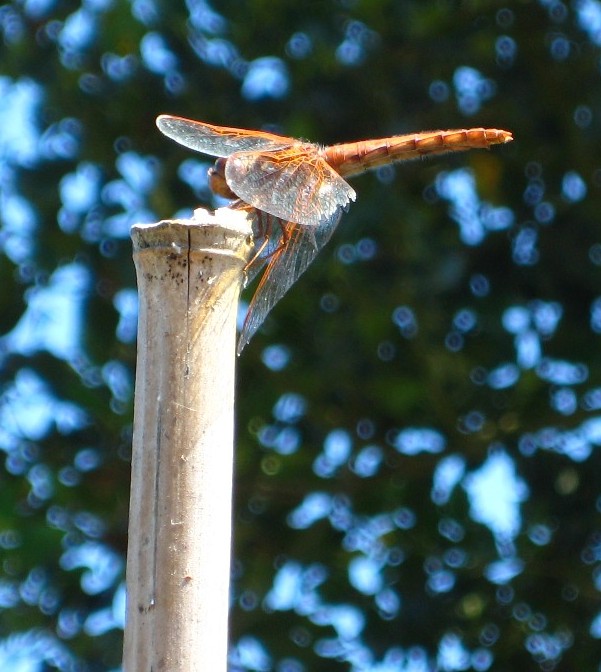December 1st, 2009 · 4 Comments
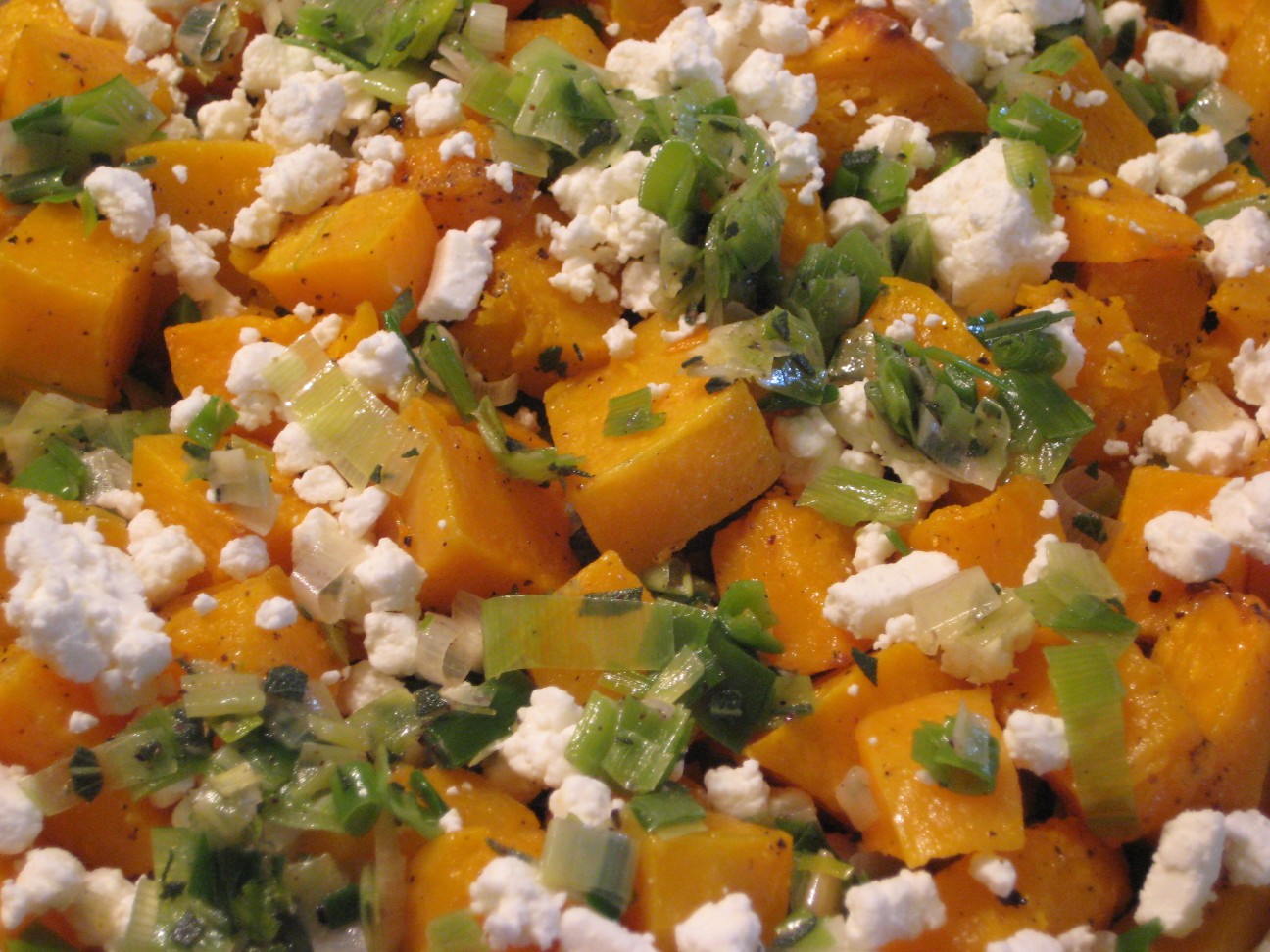
The Thanksgiving contribution…
We always celebrate Thanksgiving at my aunt and uncle’s house. It is usually a pretty big crowd and everyone pitches in by bringing a dish or two. This year was no different, except I decided to branch out a bit with one of the dishes. This year our compost volunteered many things, but most prolific of the volunteers was a large and rambling winter squash vine. It produced two large squashes which looked to be some cross of delicata and butternut (but significantly larger than either of those varieties). While most impressive looking in the garden, and tipping the scales at well over 10 pounds each – we were unsure if they would actually be edible. Cross pollination mysteries can be a lot of fun, but they can also result in nasty, bitter flavors occasionally.
The night before Thanksgiving we decided to sacrifice one of these beauties and take it for a test run. It was great, sweet and dense without a bunch of excess water. I surfed about in search of a recipe and found one that fit the bill on Epicurious. I grabbed a bunch of leeks and sage from the garden and was ready to go. The one non-local ingredient used was walnuts. The epicurious recipe actually called for hazelnuts – a local and delicious option and had I had any in the house I would have used them instead.
While cleaning the leeks I came across this one. Apparently at some point during the summer this one got a little backed up in its growth.

Local: Squash, Leeks, Sage, Cream, Goat Cheese
Non-Local: Olive oil, Walnuts, Salt, Pepper
*This post is late and may not make it into the summary roundup. I managed to catch a post-holiday cold and have not been up for much of anything until today.
Tags: General
November 20th, 2009 · 7 Comments
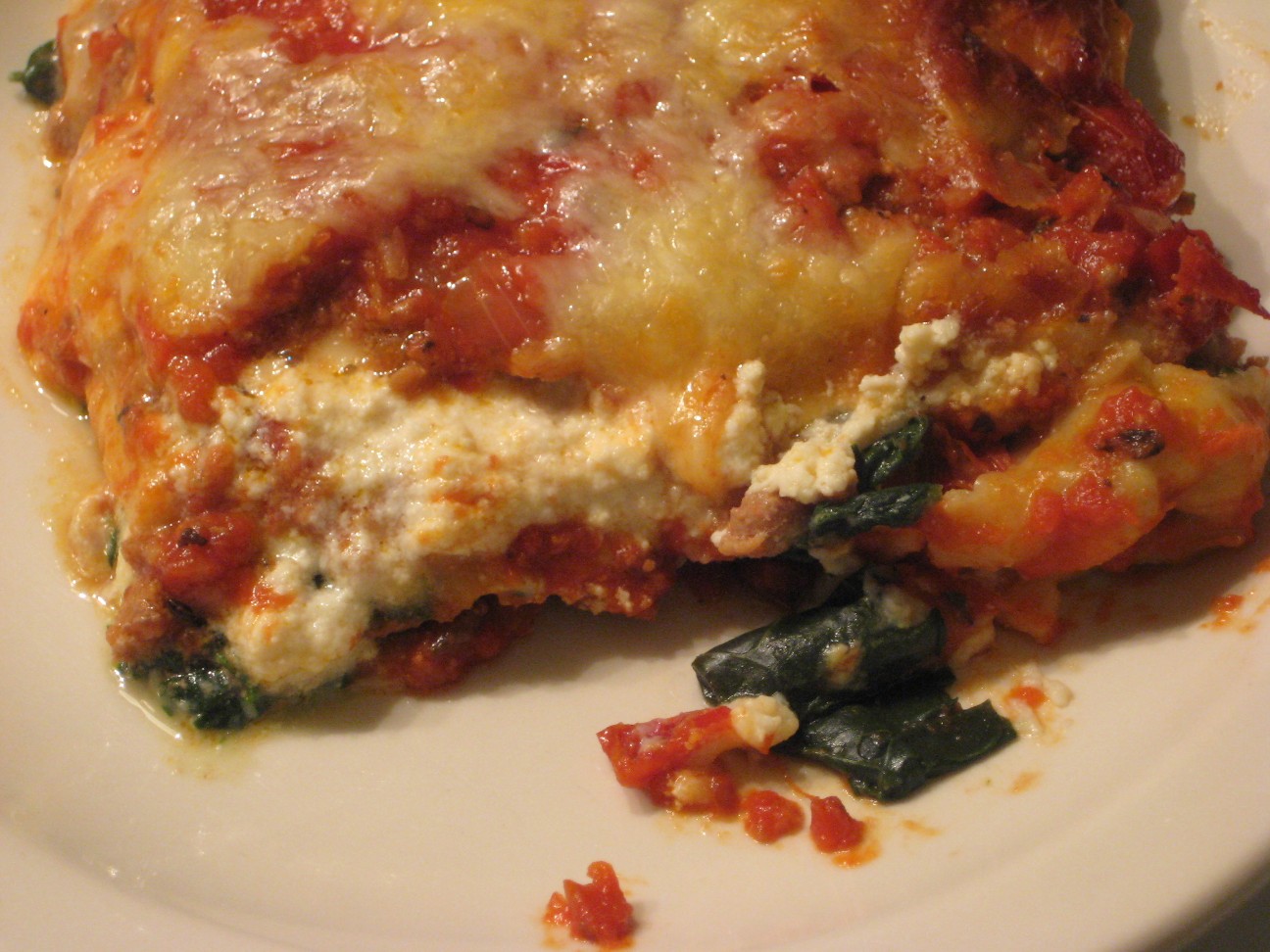
Despite my best intentions of increasing my posting frequency this summer, it seems the year got away from me. However, I resolve to do better over the dark days of winter and part of that entailed signing up once gain for (not so) Urban Hennery’s Dark Days challenge. For those unfamiliar – a quick synopsis is here.
So – to kick off the brand new winter season and first in a long line of Dark Days posts, I bring you…..leftovers. A bit anti-climactic, I know. But somehow when you think about it, a meal comprised of leftovers that meets the Dark Days requirements is exactly what the goal is, right? Local, wholesome, ethically raised and sustainably grown food should be the norm and not the exception in our roster of weekly meals.
We just purchased a new (to us) freezer in anticipation of our 1/4 beef coming from Prairie Springs in December. As part of the transfer and clean out I’ve been preoccupied with using up all of the various odds and ends that were stashed in the freezer over the past year. A brief perusal of the ready made and frozen shelf a couple days ago yielded a few containers of bolognese, a half tub of bechamel, a container of roasted garlic ricotta and some additional marinara sauce.
The bolognese I made a big pot of earlier this year, from our own canned tomatoes, beef from Prairie Springs and pork from Whistling Train. The bechamel was comprised of Golden Glen milk and Wheat Montana flour (purchased from the cooperatives store in MT while on vacation). The marinara was our own tomatoes and the ricotta was homemade with a head of roasted farmers market garlic thrown in for flavor.
With almost all of the makings for lasagna staring back at me from the freezer, all that really remained to be done was the noodle element. I used some of our new bag of Shepherds Grain* flour and a few eggs to make lasagna noodles and also pulled out a bag of frozen lambs quarter that I harvested from the backyard earlier this summer. Layers of marinara, noodles, lambs quarter, ricotta, bechamel and bolognese found their way into the casserole dish and an hour later we had dinner.
Last nights dinner did constitute a bit of assembly, but I do love it when a meal just comes together with a minimal amount of effort. And what the meal lacks in photogenic appeal it more than made up for in taste.
Local Food: Beef, Pork, Flour, Milk, Garlic, Lambsquarter, Tomatoes.
Not Local: Olive Oil, Eggs**, Salt, Nutmeg.
*I cannot rave enough about this product (and company). I had been searching for quite a while for a more local source for flour – and found that and even more in Shepherds Grain. Their whole wheat flour is delicious and a fantastic product for baking 100% whole wheat goods that don’t weigh half a ton. In addition to the quality, this is a cooperative of farmers committed to sustainable agriculture. They practice direct seeding (no-till) and are Food Alliance certified. For those in the Seattle area, their products can be purchased in 50 lb sacks at Merlino Foods (you have to call ahead to order). Try it, you’ll like it and support folks on the other side of the mountains trying to do the right thing.
**Questionable, they were organic – but derivation was unknown. Our girls have been on strike for months now and this was a carton picked up from Costco in a moment of weakness.
Tags: General
November 3rd, 2009 · 1 Comment

Words will follow at some point….
Tags: General
September 11th, 2009 · 8 Comments

At long last I finally got around to uploading some of the pictures from our visit to the Bullock Brothers homestead on Orcas Island at the end of August. It was a veritable wonderland of food laden forests, millions of projects and experiments in process. The majority of thier land occupies a southfacing slope that leads down to a recovered wetland (before the Bullocks moved in, the valley bottom had been drained for crops). This picture is facing the lowest point of the property on the gentle curve of where the land slopes down to the water.

Fruit trees, little annual plots and berries abound. Old Sears and Roebuck homestead pumps powered on solar panels pump the water stored in the wetland back up the crops and trees planted on the hillside. The excess eventually makes its way back down again.
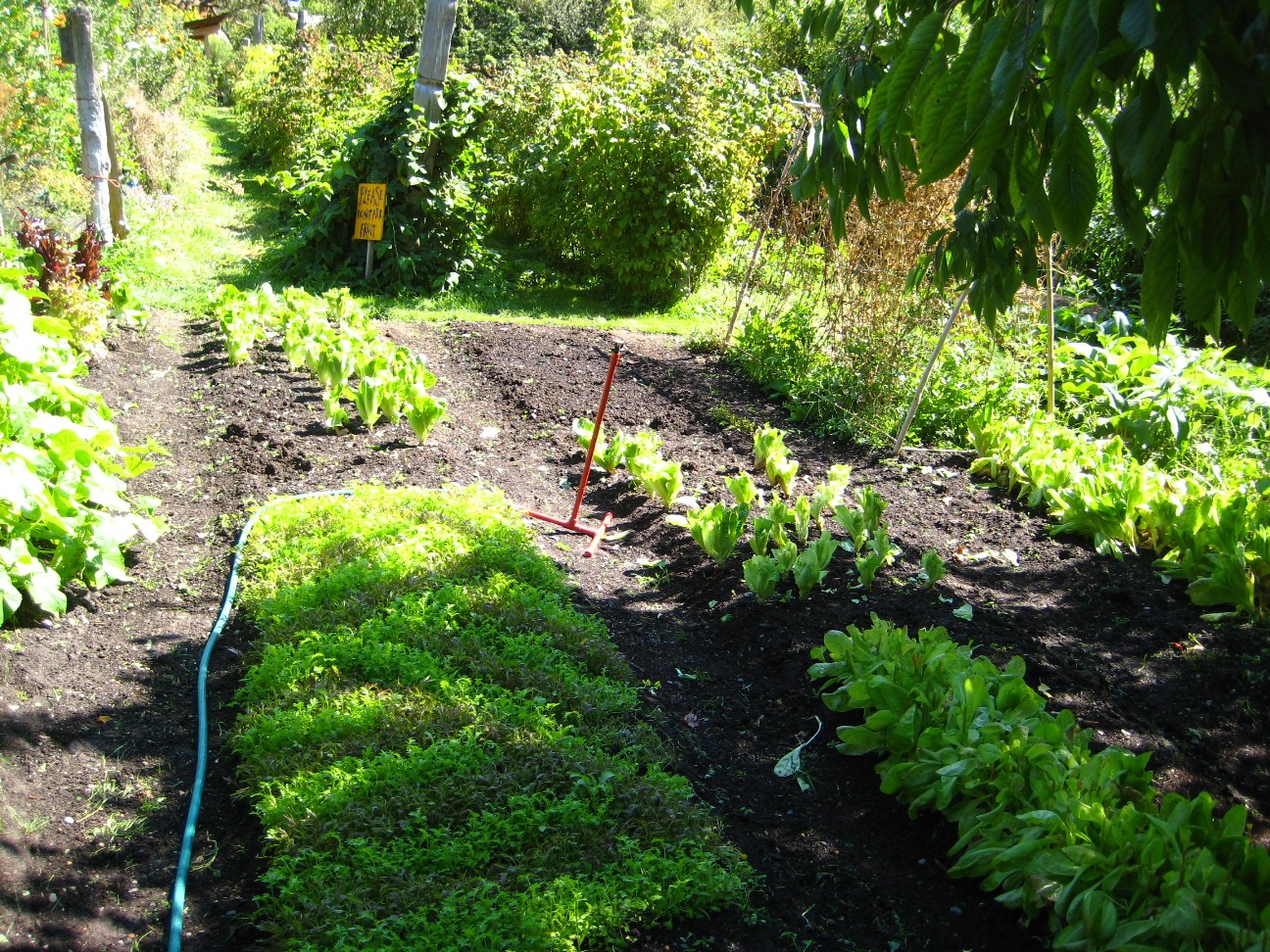
I was secretly happy to see that the majority of the annual beds were in a rather traditional rectangular arrangement. Permaculture manuals are all filled with these mandala-style beds, which are great if you have a lot of space (and a small army of labor and materials to construct them) but are pretty intensive for someone working with a very limited amount of space – City lots are square you know. The rectangular shape of the beds makes it easy to move a chicken tractor along the bed at the end of the season to turn up the soil.
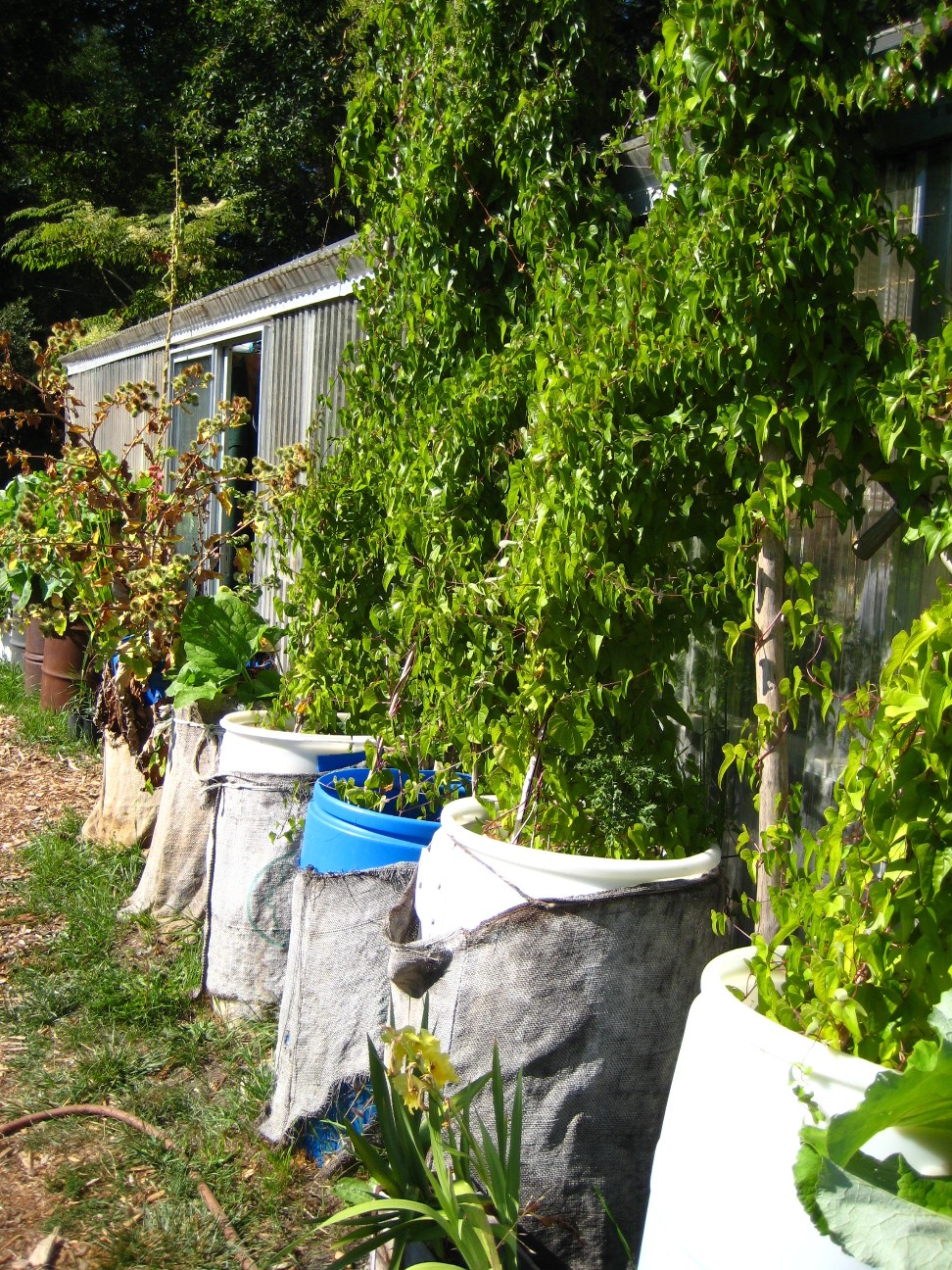
Chinese Mountain Yam and Burdock(both perennials) growing in 50 gallon barrels. This is a brilliant idea that I am going to work towards putting in action on our patio next year. Right, this just looks like an oversized container garden of vines. But the brilliance lies hidden behind the burlap bags covering the barrels. Each barrel has actually been cut fully in half vertically and then put back together with makeshift hinges. This allows you at harvest time to just turn the barrel on its side and open it up clamshell style for harvesting the tubers. You can then leave enough for next years crop, put the top portion back on and turn right side up again. No dumping and sorting through the entire mess.
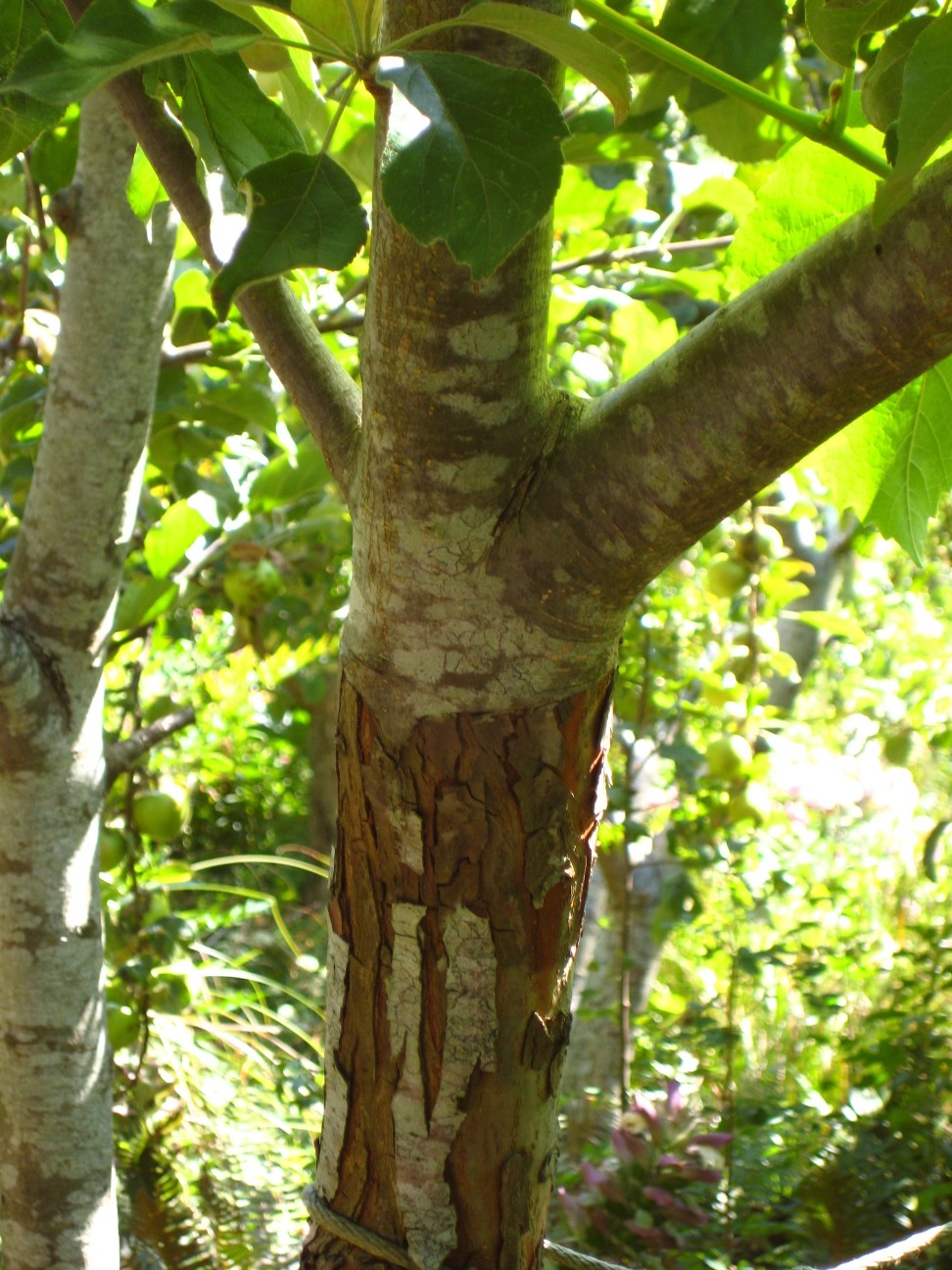
Ahh, the grafting! This is an apple grafted to a native Hawthorne tree. Perhaps one of the most exciting things I learned in the class that Doug Bullock taught a couple months ago was the endless possibilities that grafting presents for using already established rootstock to produce food. Imagine taking all of the ornamental non-fruiting plum trees and grafting on other stone fruit branches. Within a few years you could have plums, nectarines and peaches all off of the same tree which presented no food value just a short time ago. Also, taking advantage of already present, native varieties of trees in the same family allows you to cheat strict soil and climactic requirements of some of our more tasty, but domesticated cultivars.
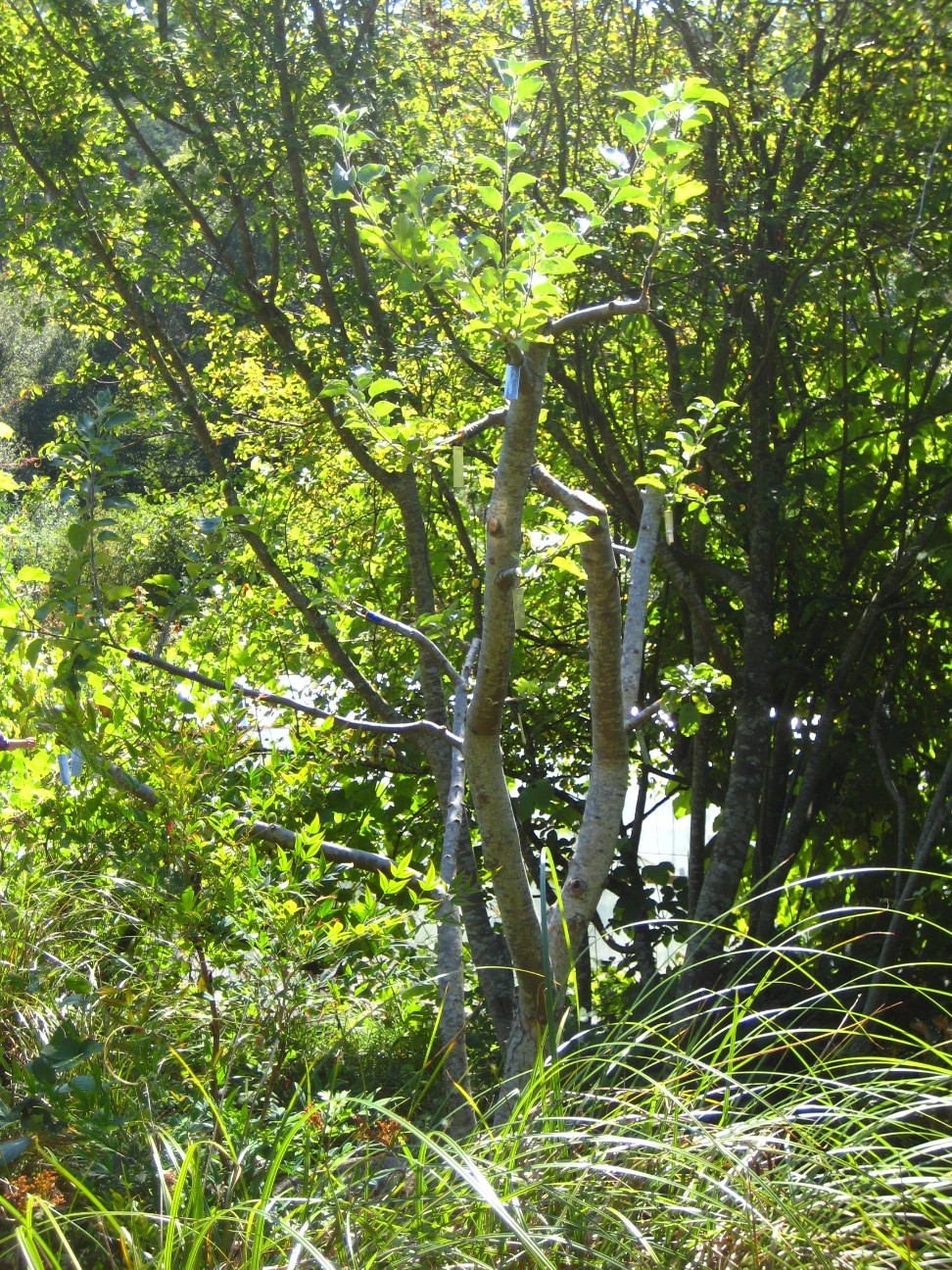
This is a picture of a tree that was quite obviously recently grafted with a large number of different scions. If you look closely you can see the silver tags hanging off each branch identifying the variety. The sun was out that day and not very cooperative with my goal of getting good pictures, everything is a bit overexposed.
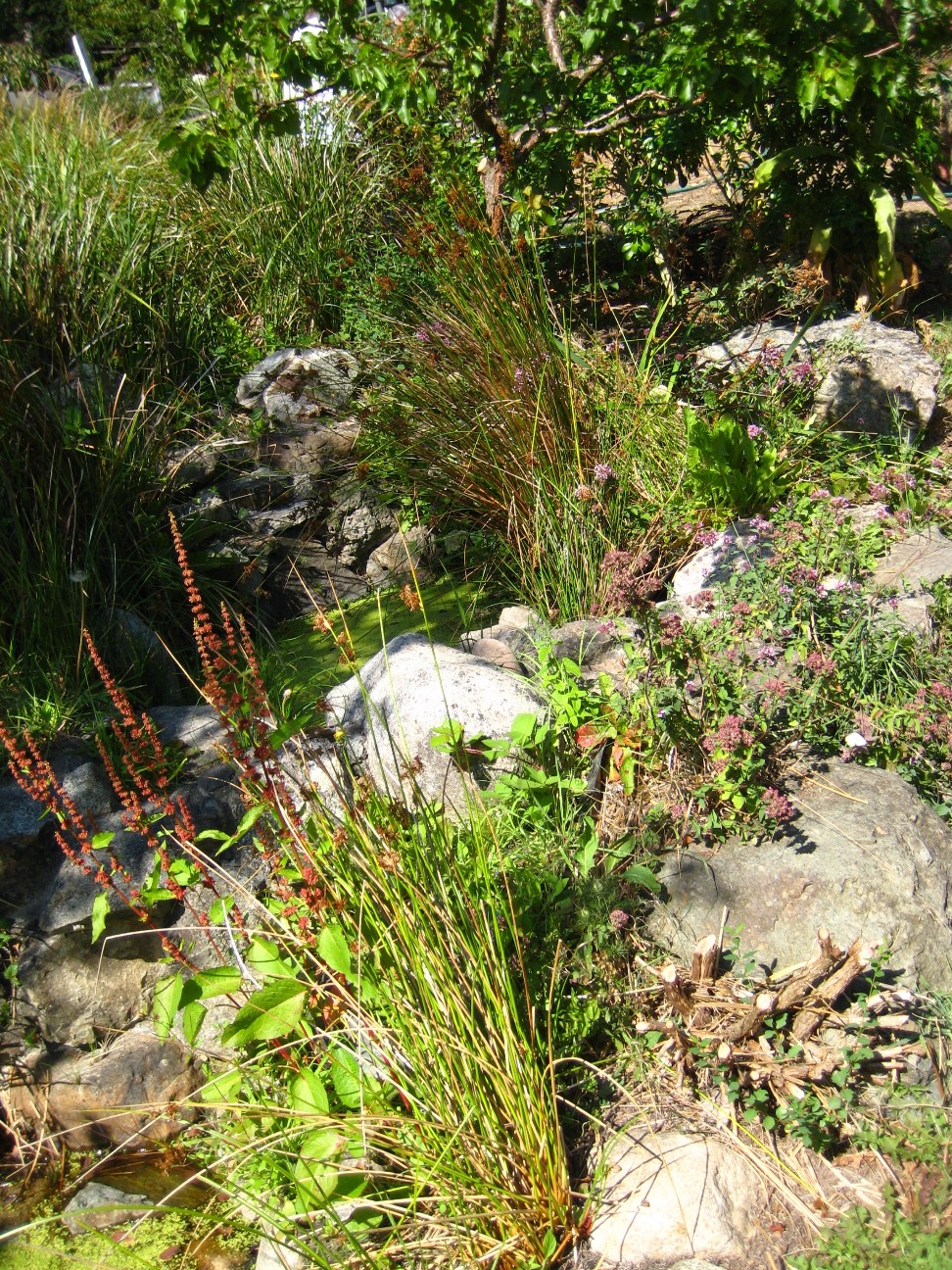
This is a series of two ‘greywater’ pools that are fed from the excess water coming off of nursery tables just up the hill. This eventually drains down into the wetland again, but provides a bit of habitat along the way.
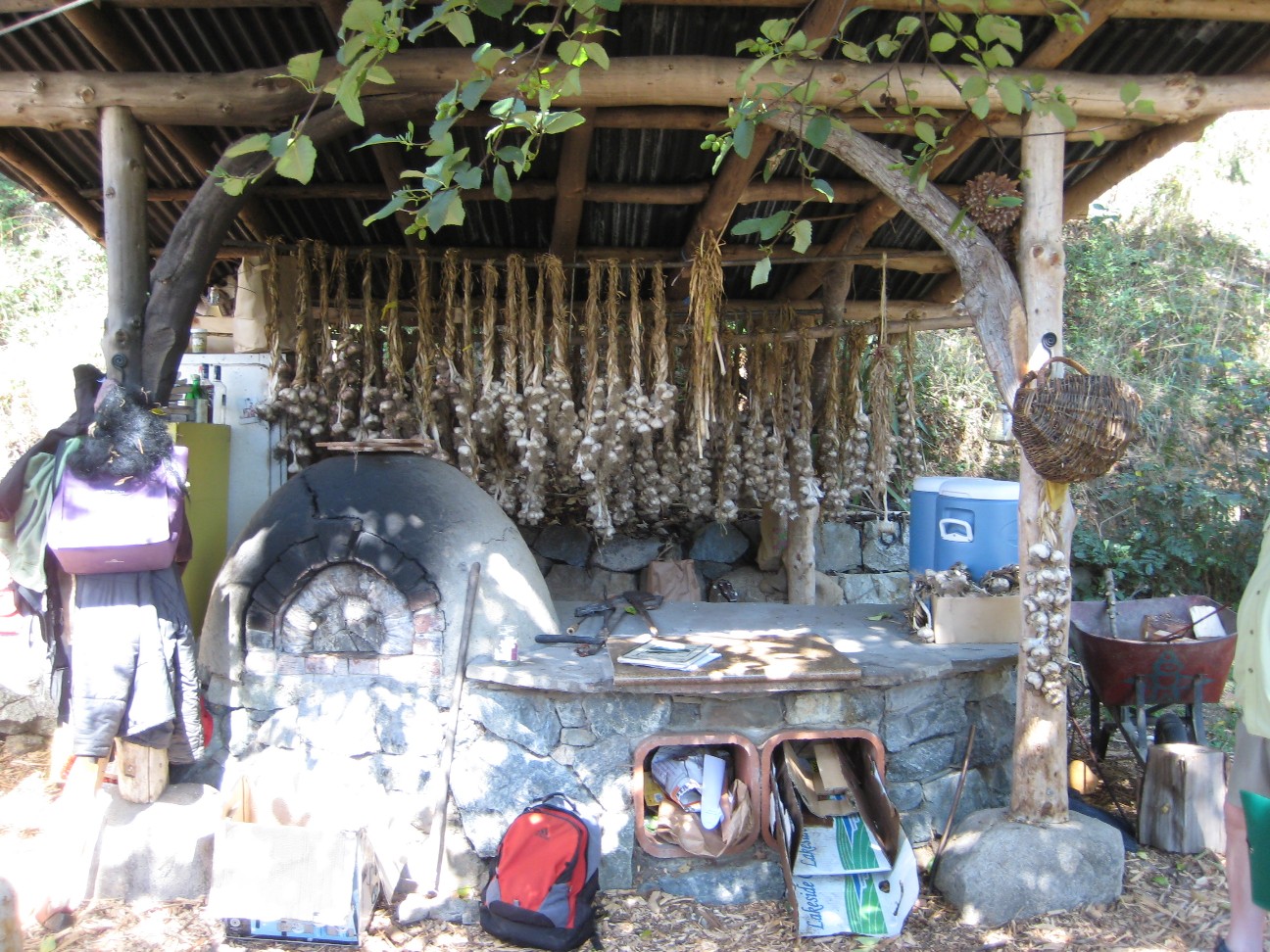
Part of the intern kitchen. Note the Cobb oven on the left and the gorgeous braids of garlic in the background.

A recently completed Cobb Rocket Stove – so cool.

Picnic and rest stop. This was a rather large arbor constructed mainly of whole logs. It supported grapes, arctic and hardy kiwi and was a cool spot to relax. It was also being used as a semi-shade location for some seedlings.
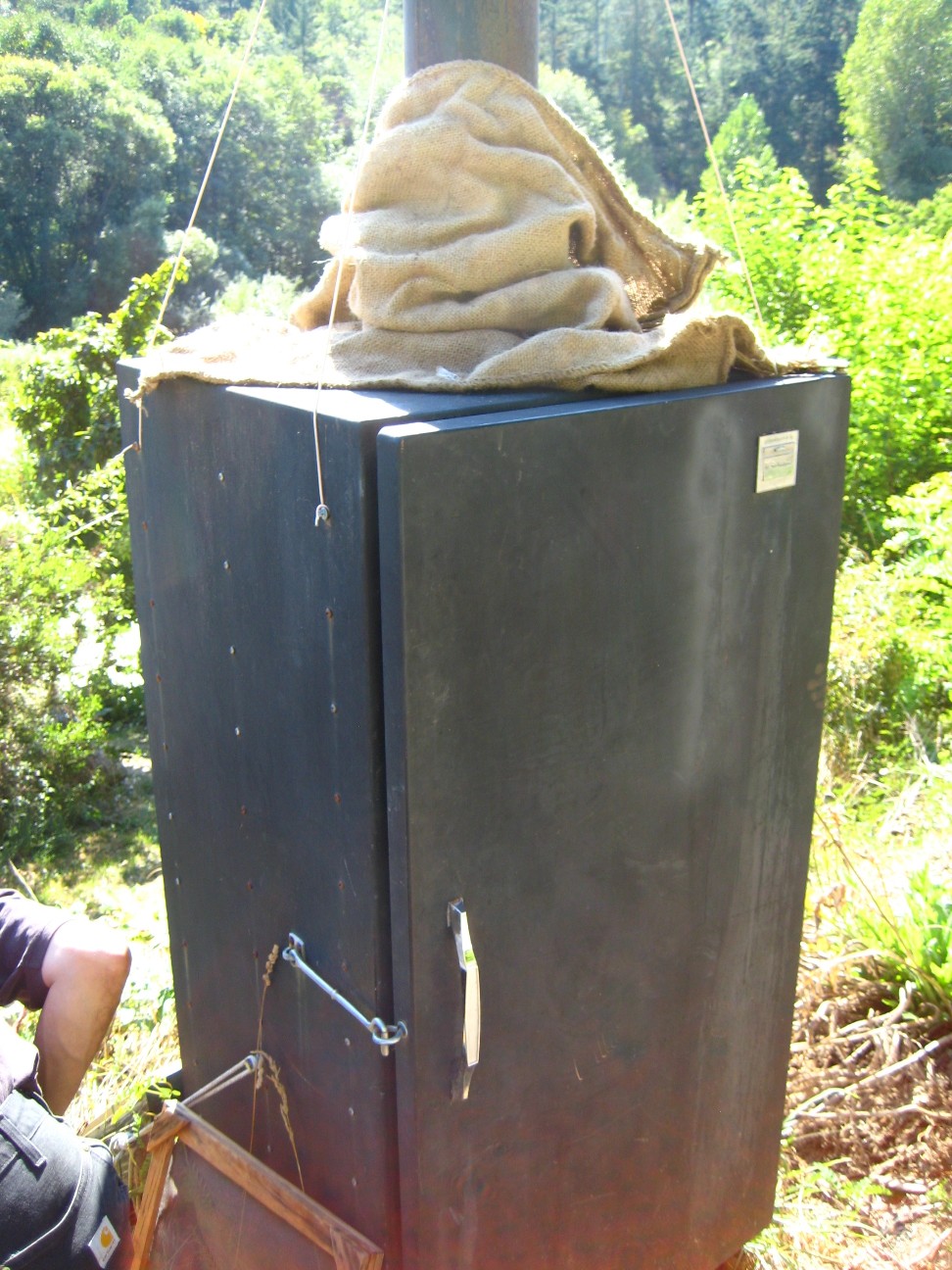
The homemade solar dryer, courtesy of Frigidaire. The inside was remodeled to hold a stacked series of drying screens and on the backside a solar collector (once again on the south slope) funneled hot air into the box.
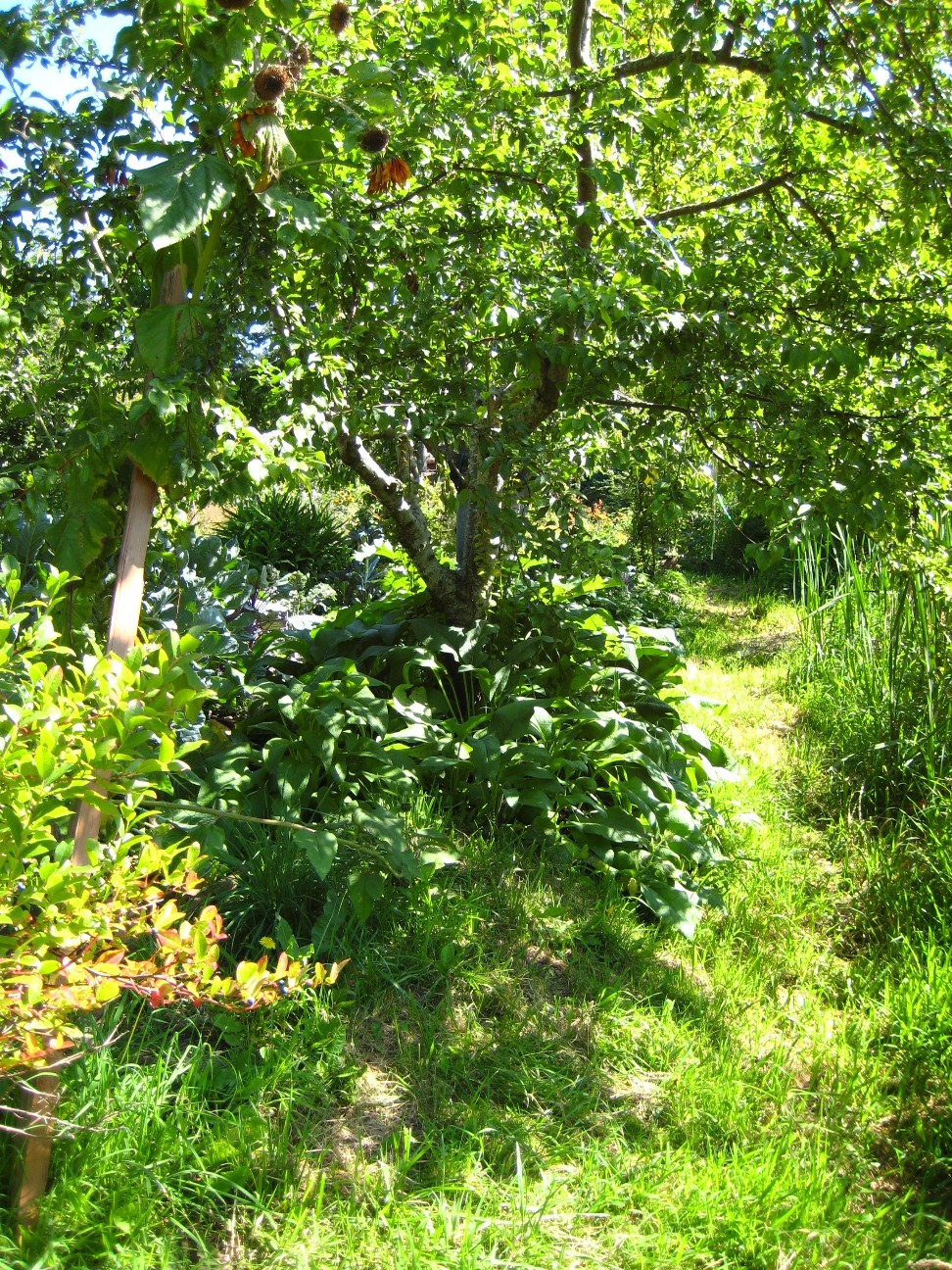
Waters edge. On the right you can see reed and other water grasses marking where the water begins. On the left is a blueberry, medlar and large cherry tree surrounded by the ever-present Bullock signature comfrey rings. They plant comfrey around each orchard tree. Comfrey has a deep taproot that brings nutrients up to an accessible soil level for fruit trees. The comfrey can be cut back and mulched in place 2 to 3 times each year, returning even more to the root zone of the trees.
In all it was a fabulous trip and I am a bit sad we didn’t get to camp as originally planned (so we could explore a bit more on our own). There were many other inspired ideas that I didn’t manage to take pictures of that are still jumbling around in my head. I was also glad that Gary came along for the tour as he seemed to catch a bit of the bug after seeing all that could be achieved. It is a bit strange being the lunatic that comes home after each class scheming with grand ideas. Not that he doesn’t share (at least some of) my vision, but not being immersed possibilities for 16 hours at a time does allow one to take a bit of a less immediate view of things. This, contrasted with me, so overwhelmed with all that we could be doing that I want to get at least a few things rolling right away.
And this brings me to my final impression – both of the Bullocks place and what I have gathered from the class and presenters. One needs brothers. I noticed that out of the three presenters we’ve had so far – two (coincidentally the two that own their own homestead) started out their presentation with something along the lines of “10-26 years ago I bought this place with my brother(s) and we’ve been working on it ever since”. In addition to the brother factor – large scale operations like the Bullocks place benefits greatly from a small army of 10-12 interns each year. A young, eager, twenty-something brute labor force brimming with inventiveness, renewed each spring and at their disposal in exchange for some hands on learning.
It all points toward a greater need for the rethinking and re-figuring of community. I’ve spoken of this before in more simple terms of having local friends to sit down and talk seeds, cooking and gardening with. But it extends much past that when we start to think about creating networks that even faintly approach a closed system. We’ve got to get a lot closer to our neighbors than our current culture promotes, and our friends have to be more than someone you grab a beer with on a Friday night. In reality, this is a separate post entirely (one that I’ve started twice and not yet managed to wrap into a concise enough package for blog-friendly reading). I struggle with my own desires to create a small, simple and self-sufficient(ish) life, knowing that for it to be truly effective it needs to be a joint effort bigger than my little home and family. But I also struggle with the idea of intentional communities. I am uncomfortable with the two extremes they usually take – either uber-creepy survivalists or woo-woo hippy enclaves. I don’t know the answer, but I certainly am thinking about it.
Tags: Gardening

er… Bullocks I mean – as in the Bullock Brothers permaculture homestead on Orcas Island.
Tags: Minutae
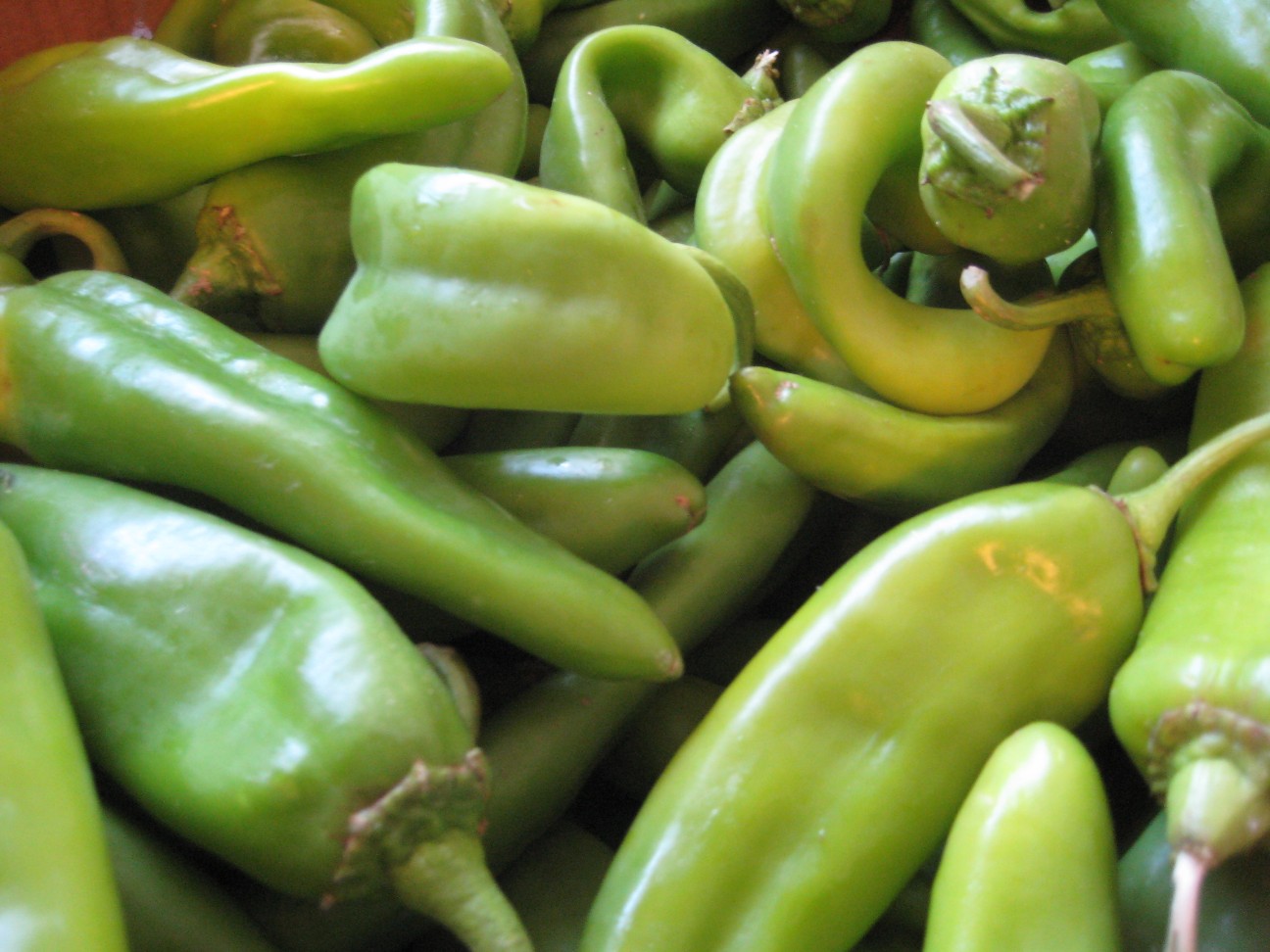
26 pounds of fresh hot Hatch green chile from New Mexico. I was born in New Mexico and although it has been almost 24 years now since we moved away, there is little that can compete with a big bowl of green chile as the ultimate grounding and centering meal. No – this is most definitely not a local meal, but I don’t care. I’ve tried to make green chile with peppers closer to home (usually from the eastern side of the state). But Washington’s anemic Anaheim peppers don’t even get close to the level of flavor or heat a Hatch chile packs in it slender green package.
My dad gave me a call the other week when he heard an advertisement on the radio that one of our local supermarkets was selling fresh chiles for a limited time. By definition, fresh Hatch chiles are only available for about a month since they are only grown in one region of NM, thereafter they ripen into the red chiles tied into ubiquitous ristras or pulverized into powder for other, truly delicious applications). The Pacific Northwest-New Mexico phone tree fired up and everyone we know was notified.
The only other way to get green chile is to either know somebody who regularly travels down there or pay an insane amount of money to have frozen packages shipped up here (at last check it was somewhere around $150 for 10 pounds). Prices like that are not within my budget, and while I do still have some family down there that brings us beautiful chile care packages when they visit – fresh chiles are a little hard to get on a plane in any substantial bulk and they are only available in August/September (timing doesn’t always work out).
So – after waiting over a week for my special ordered box, I spent the large part of yesterday afternoon and evening roasting and peeling the peppers. Despite wearing gloves the entire time, my hands were absolutely on fire for several hours after I had finished. I froze the bulk of the peeled and diced chile in quart bags and also for the first time canned seven jars of the chile to see how that worked. The jury is still out as I haven’t tried it yet, but if it is palatable it will be a nice way to preserve in the future. Gary-of-the-tender-mouth knows nothing of the pure joy and deliciousness that is green chile so being able to package it in ready to go single servings will be great.
So, I’m feeling mighty rich right now and well prepared for winter! And, although the elevation and weather is all wrong – I still saved a big handful of seeds to experiment with next year to see if I could at lease get a plant to grow.
Tags: Cooking
Masanobu Fukuoka, in The One-Straw Revolution: An Introduction to Natural Farming describes using daikon radishes to (almost) passively aerate and amend his soil. The daikon tills deep into the ground under its own steam and when the growing top is lopped off, it composts in place – providing food for the soil critters and improving the soil condition. I think this is absolutely brilliant, and have several times contemplated doing it in some of the more challenging sections of our yard.
The opportunity presented itself the other week when I was faced with having to take out a massive number of parsley plants from one of the main beds. I had a plant go to seed late last year and this resulted in a bumper crop of parsley (almost to the detriment of anything else planted nearby). Parsley has a long taproots, much like dandelions and carrots. I decided to go ahead and take the a different approach in clearing the bed and took a small paring knife out with me to cut off the green plant material just below where the root began. This allowed me to preserve the parsley in bunches that held themselves together by the top of their root, until I could dedicate time to cleaning and bundling the harvest and it also ensured that there would be no regrowth in the areas I wanted to reseed for fall.
So far it has worked like a charm. We amended the entire bed with a thick layer of compost and seeded into that. The parsley roots are busy rotting 6 inches or so underneath the current soil level and hopefully creating nice channels of organic material in what was becoming a very sandy bed . This is a bed we had to import soil from offsite to fill after construction 3 years ago. At first it was a dreamy bed full of compost, but as the organic matter burned away we were left with an ever increasing ratio of sand. The mix was advertised to be loam, compost and sand – but I have yet to see anything remotely resembling clay. Funny after so much complaining about Skyway Clay, that what we really need is clay now. Despite my vows to not till our garden, I may end up rototilling the whole bed at some point just to get a bit of water retaining clay added to the mix.
After we pull our fall greens from this bed I plan to cover the entire bed in a deep mulch for the winter and let it rest and rot. Hopefully the focused organic material will improve the bed significantly for next year’s garden.
Tags: Gardening
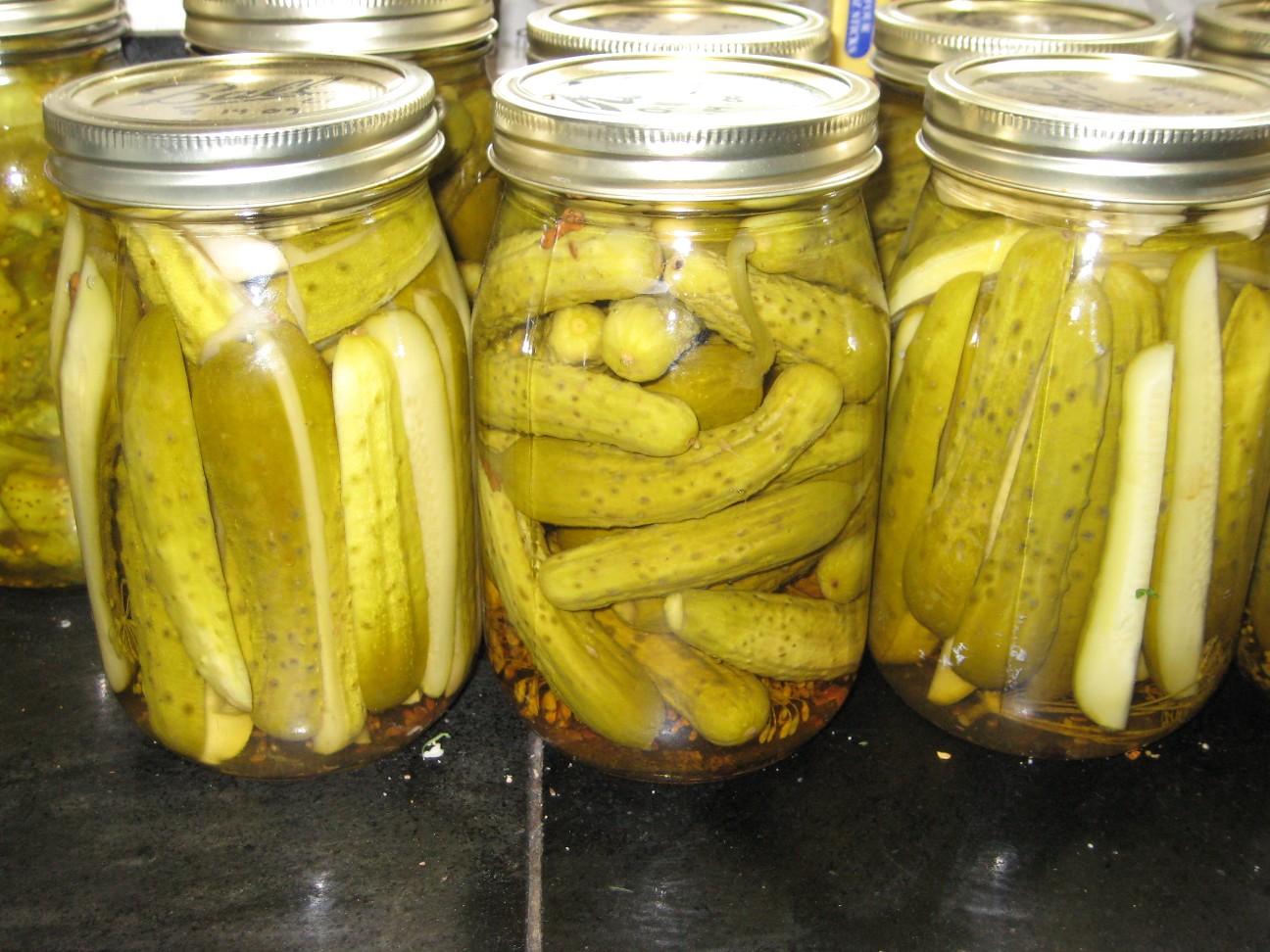
Canning season is upon us. In this house it actually never really ends since I find myself canning up big batches of chicken stock every couple months from the trimmings and bone I hide away in the freezer after we roast a chicken. But the preservation of summer’s gifts has officially begun. It all started in drips and drabs with the strawberry jam making sessions and assorted fruity booze experiments. But last Friday made it official with pickle time. I made a large batch (mixed whole and spears) of Laura’s dill pickle recipe (I’ve had the chance to taste test these myself and they are fabulous). I also made a batch of Bread n Butter pickles and dilly beans. With the smallest of the cucumbers I made a few jars of french style cornichons (no dill) to accompany the remainder of the pate’s still stashed in the freezer. If I can fit it in, tomorrow I hope to head out once again to Duris Cucumber Farm to pick up another bag or two of freshly picked cukes to make a batch of lacto-fermented pickles.
Saturday morning I’ve got grand plans for Blueberry and Blackberry preserves canning session with a friend. There is a blueberry lime jam calling to me from the ball blue book, I’d like to make another batch of KitchenMage’s Blueberry Habanero Chutney and I am going to experiment a bit in using the food mill to remove some of the (excessive) seeds present in our wild blackberries for jam. Hmmm, perhaps a blackberry vanilla variation? I am hoping to get a bit of blackberry picking in this evening for a sideline trial of Blackberry Pickle and a batch of Blackberry Vinegar. I managed to injure the tendons in my right hand peeling a kohlrabi earlier this week, so it should be interesting to fully realize the dexterity needed to pick berries in a wrist brace. (Isn’t it just like me to suffer injury by kohlrabi of all things?).
Ahh the list of experiments is long this time of year. I still hope to make another harvest of the rhubarb, which has bounced back from the earlier pie extravaganza. One of my cousins procured a tried and true rhubarb wine recipe that I’d really like to get going (perhaps make a blackberry-rhubarb variation on that…). I also came across a mention of Bread n Butter Jalapenos while researching recipes that is calling out to me, so I picked up an extra bag of peppers at the Renton Farmers Market on Tuesday.
The last two nights have been dedicated to dealing with a massive parsley harvest (detailed in an upcoming garden status post). I had a plant go to seed last fall and was positively overflowing in flat leaf parsley. I bundled up a bunch of it and set them in a tub of water on the side of our street with a free sign when I first harvested. They were all taken eventually, and I hope it was enjoyed. The remaining huge bag was broken down into a parsley pesto with walnuts, lemon juice and garlic. I made several batches of this for freezing and found that the batches in which I subbed vegetable oil (canola) for olive oil I actually liked better. Somehow the canola oil came off a bit smoother and enhanced the flavor of the parsley rather than competing. Most of this was frozen immediately – but several large dollops were reserved for the first (pseudo) BLT’s of the season. Bacon from our Whistling Train pig was placed on an open faced slice of homemade bread, layered with huge, thick slices of red and yellow tomato and topped with generous spoonfuls of the parsley pesto. I don’t know if there is much in the world that tops that flavor…
Tags: Cooking · Local Food
Tags: Animals
Wow, 1 day short of a month without posting. Sorry about that! This has turned in to a bit of a whirlwind summer with extreme temperatures (and an extreme lack of water). I also recently upgraded computers and am still working on getting all of the necessary drivers and software installed to set me back to rights. (Ok, so that is the one excuse in this post and the reason for the lack of visual entertainment, no software = no digital pictures). In truth, I suspect this permaculture class has me in such a retrospective and observational mood that I am loathe to put anything down to ink and paper (figuratively at least) lately. In many ways it has given me license to contemplate (my normal state) without having to push myself out of thought and into action. I know I keep promising a more detailed rundown of all I have gleaned, but it truly is overwhelming and I think that in many ways I need to complete the design process/project and fully process things for a bit. I do intend to at least try and pay it forward to some extent here -if for no other selfish reason than the adage that teaching it again is the best way to understand and remember something.
I’ve met some pretty fantastic people and hope to develop, maintain and continue relationships afterward as well. It is actually a bit strange meeting so many people with similar interests when you have become somewhat used to being the food and garden obsessed lone wolf. in the crowd…
Other news on the home front includes a heatwave topping 105 degrees on our fair hill, temperatures unheard of and weather breaking for the area. The hot snap resulted (methinks) in the catastrophic failure of the first scarlet runner crop. A week after the super hot weather, all plants dropped all of their blossoms and all of their growing (still tiny) beans. Since cooler weather has rolled in, blooms are beginning to develop again so there may be a fall harvest (water and weather willing).
I at my first backyard ripened tomato in July that I believe I have ever eaten here in the PNW. I feel as if our tomatoes should be going gangbusters with all of the hot weather, but the truth is that they have struggled a bit this year. Most likely this is due in part to their location (the bed they are in was due for some serious amendment that never happened this spring) and the lack of spring and early summer rain. We are currently having to water from the city’s water supply and as a result are rather stingy.
We have eaten scads of broccoli and have several heads of cabbage. I am behind in making sauerkraut again as well as getting fall seeds started (what else is new?). Gary’s 3 sisters garden is producing well with tassels on the corn and patty pan squash going gangbusters. I am experimenting a bit with the dehydrator that a friend lent me. I have a baggie of dehydrated squash I plan on using Hank’s approach on this week. We gapped a bit in our lettuce planting, but have a whole new crop coming up in the shade of the Rhody in the backyard. Multicolored beets are waiting for me in the fridge and the peppers are blossoming and growing. The carrots have done well too, despite the meager water allowance.
On the downside of things; We suffered a complete massacre of our trees courtesy of the Seattle City Light hired tree service. I have never in my life seen such a hack job as they performed on the Crimson Maple and Douglas Fir in our front yard (and the other trees on the block). The turf war/pissing match between City Light and the other utilities is very evident in our front yard. Imaging a full tree outline, now take the uppermost left quarter completely away. That is what our 50+ year old Crimson maple now looks like. All limbs even looking sideways at the power lines were cut back to the trunk – but all limbs entangled in the phone, cable and other lower utility lines remain. We are now left with decisions to make on what to do with 1 and possibly 2 irreplaceable trees that have been incredibly compromised. The “free” service that the utility trimmers provided will likely end up costing us a thousand in tree removal when the time comes (at least for the Fir).
Really and truly there has been a lot going on and I sense even more burgeoning in the next two months. There are additionally some home improvement tasks that need to occur before the end of September. Namely the replacement of the two old windows in my office. Ahh the fun never ends!
This post turned into a bit of a laundry list, but so goes life I guess. So how are your summers treating you (Do I have any readers left…)?
Tags: General




















